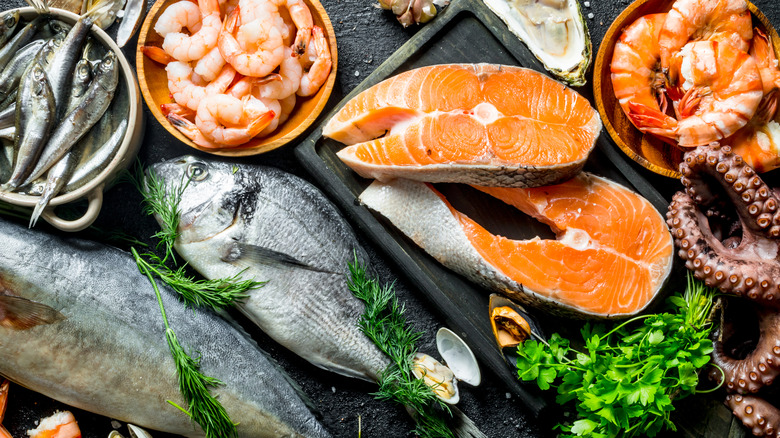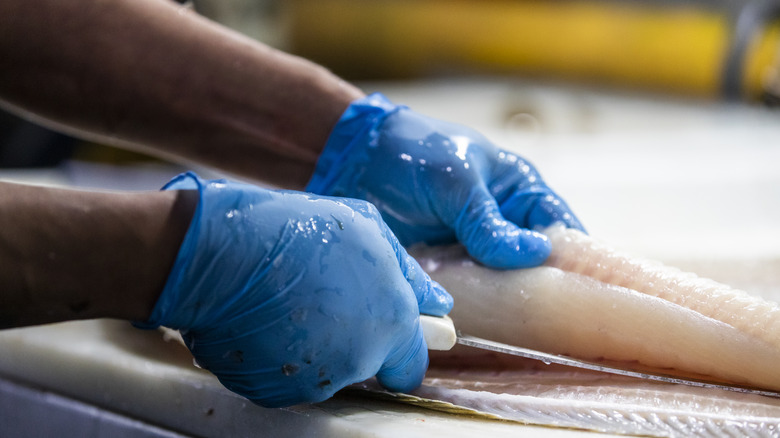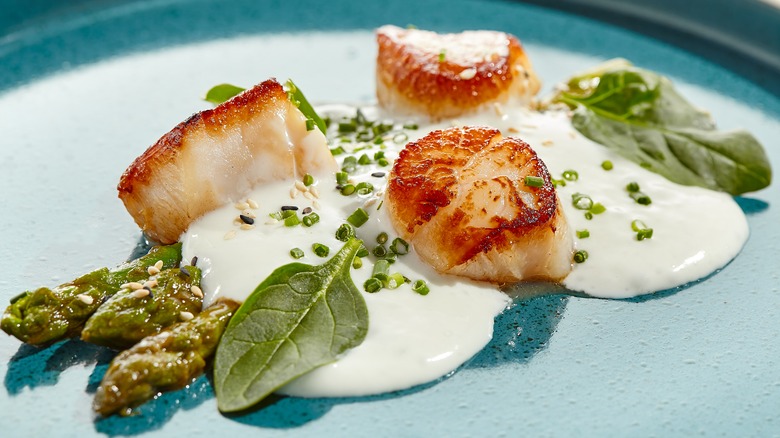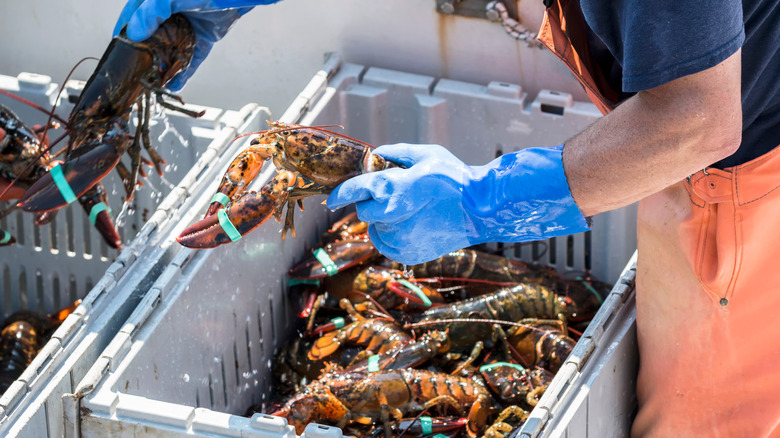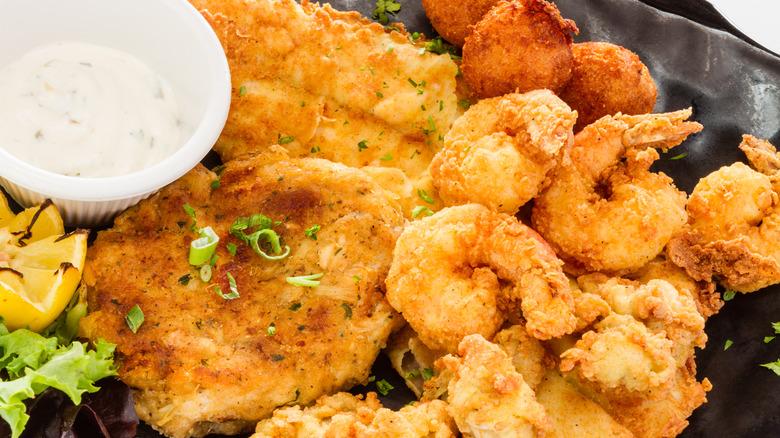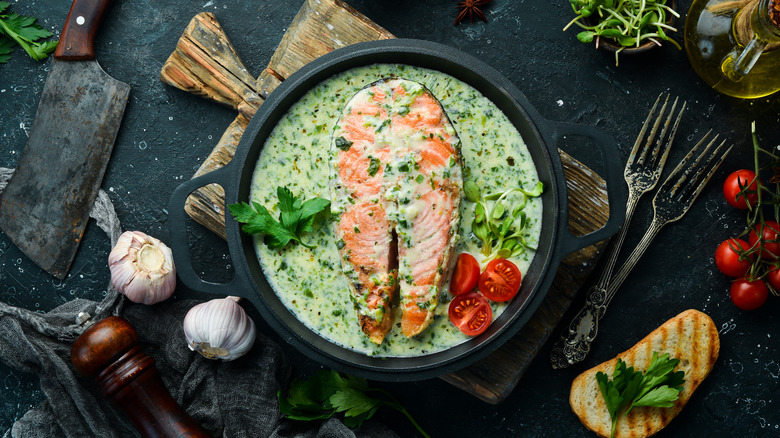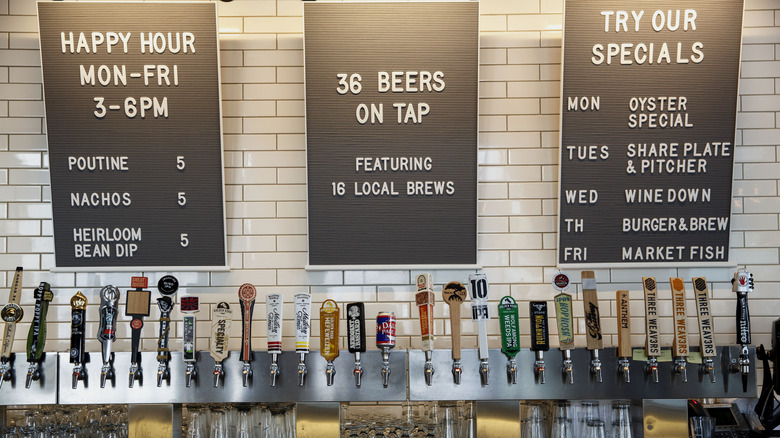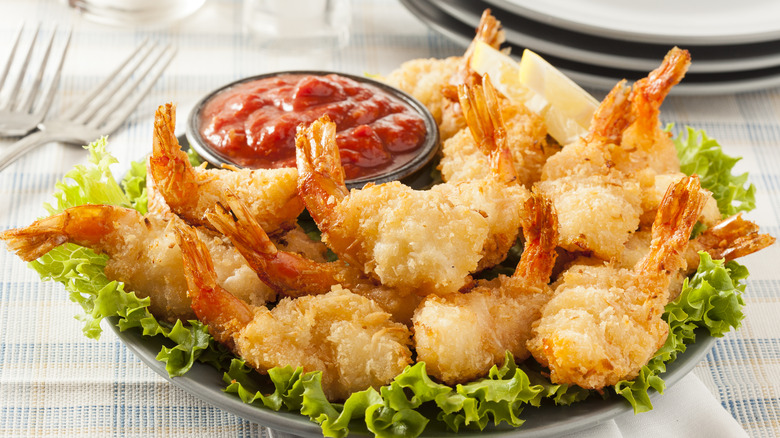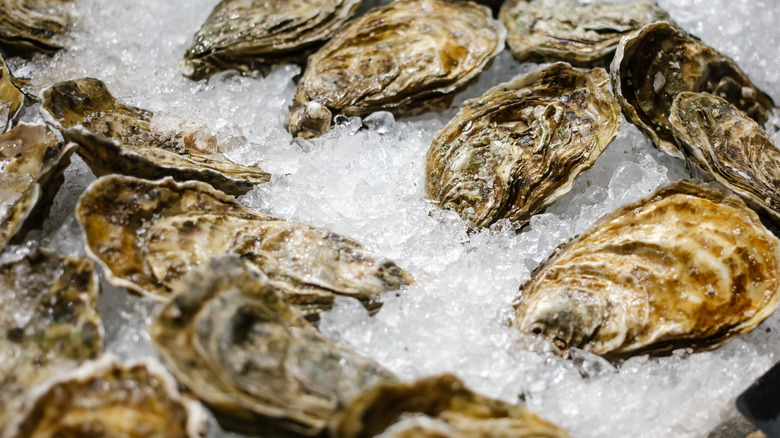11 Red Flags To Look For At A Seafood Restaurant
In the United States, 70% of seafood is consumed while dining out (via The Counter). People might still be intimidated by cooking fish at home (though they needn't be, with the right recipes). Plus, going out for seafood feels like a luxurious treat often associated with summer and beach vacations, which may make people want to devote their seafood budget to restaurants instead of the fish case at grocery stores.
Unfortunately, there is a shocking amount of fraudulent seafood on the market. Oceana reports that 25% to 70% of seafood is intentionally mislabeled, primarily to pass off cheaper species as the more expensive ones in high demand. Perhaps due to the distance between the fishers and consumers, bad actors in the market feel like they can get away with these deceitful practices.
To help you avoid the trickery, we've compiled a list of red flags to look for when dining at seafood restaurants. Whether you live in a coastal city or in the Midwest, you can find restaurants that care about serving quality fish alongside those trying to fool their customers. Keep these points in mind next time you crave a feast from the sea, and you'll be equipped to have an authentic and enjoyable experience.
They don't get fresh fish every day
A longstanding piece of advice when it comes to dining out is that you shouldn't order fish on Sundays. This widely held belief is based on the assumption that restaurants get seafood deliveries on Tuesdays and Fridays, so when you order on a Sunday or Monday, the fish will have been sitting around for days.
In certain contexts, this is good advice to take. Restaurants that don't serve much fish probably only get a couple of deliveries per week, and many restaurants are closed on Mondays. However, a busy, high-quality seafood restaurant is going to need fish more often than twice a week. Boston-based wholesale fish buyer Richie Taylor attests that top-quality restaurants will make an effort to have fresh fish every day of the week. Even restaurants in the Midwest can serve fish caught just a couple days ago due to the speed of air freight (via Sauce Magazine).
A restaurant likely won't advertise that they don't get daily deliveries, but you can still do some sleuthing. Let your nose do the detective work. If a restaurant smells overly fishy, they likely have old product lying around. Fresh fish will not be smelly. Also, don't be afraid to ask your server when they last received a seafood order. There are plenty of seafood places that want to give diners the freshest fish, so aim for restaurants that bring in new product nearly daily.
The menu lacks variety
The American seafood palate strongly favors shrimp and salmon (via National Fisheries Institute). They account for nearly 8 of the 19 pounds of seafood consumed annually per capita in the U.S., but that doesn't mean these are the absolute best fish available. If a seafood restaurant only serves variations of these two items, they are not tapping into the full extent of the ocean's offerings.
There is nothing wrong with having these popular foods on the menu; restaurants know shrimp and salmon dishes will sell. Though menus don't need to be miles long, a quality seafood purveyor should offer at least a modest range of shellfish, salmonids, whitefish, and unique specialties (black cod, for example). The best places will update their menus almost daily but at the very least weekly to keep up with the fresh catch. They may serve a whitefish dish featuring cod one week when it's fresh then switch to hake the next. Skilled seafood chefs will know how to adapt similar seafood items in their recipes.
A trend that took over menus in 2022 was whole fish. You are probably in a good spot when you see whole fish on a menu. This indicates the chef knows how to prepare it and may even bring in other whole fish to process in-house. Fish is generally considered freshest when it has just been filleted (via Wild Seafood Market).
Menu items aren't seasonal
People mistakenly think most fish species are available year-round, but it is a highly seasonal food. Fish don't just suddenly abandon the ocean a find new homes, but they are wild animals. Many species migrate to different areas throughout the year. For example, wild king salmon (chinook) from California is only available fresh during short periods in the summer when the fish are migrating to rivers to spawn (via Monterey Bay Fisheries Trust). The commercial seasons are set to allow fishers to get their catch while ensuring enough of these salmon make it to the river mouths to reproduce. Commercial fishing is highly regulated. The seasons are set by region and may be dependent on a number of factors, but the general purpose is to promote the sustainability of species (via NOAA).
By learning the seasonality of fish, you can better assess seafood restaurants. Look for menus with seasonally appropriate items to feel more confident you are getting the fresh catch. In the fall, you can hope to find fresh bay scallops at their peak, but wild king salmon on a menu in December should tell you that fish may have been frozen six months prior. While freezing fish doesn't necessarily destroy its quality, when you dine at a seafood restaurant, you probably want to experience the best fish available at that time. Just like with produce, you should expect to see major menu changes at least quarterly to account for seasonality.
Unsustainable species are on the menu
If you attempt to structure your diet around sustainability, it can feel like a gut punch to learn you might need to give up one of your favorite foods, and seafood is a food group often under scrutiny. The Monterey Bay Aquarium's Seafood Watch program assesses fish species and gives guidance on which are sustainable options and which ones should be avoided. That red rating (meaning avoid) may be assigned because that species is overfished or harvesting practices threaten other marine life or the environment, and there are a lot of popular species with that dreaded red rating.
Unfortunately, bluefin tuna is one of those species whose population has been threatened by overfishing. Bluefin is highly prized for sushi preparations, but more sustainable tuna varieties, such as yellowfin or albacore, have better-managed numbers. Menus will often specify the type of tuna used, but you can ask for clarification.
Look for restaurants that take sustainability issues into consideration when crafting their menus, as protecting marine life today will allow for fish to continue being consumed for generations to come. They can earn bonus points for celebrating an overlooked fish species, such as tautog or dogfish, which boast both wonderful flavor and healthy populations.
They can't tell you where the fish was caught
Most likely the chef at your favorite seafood restaurant isn't showing up at the docks to get the daily catch directly from fishers. It is much more likely they get their seafood from a trusted wholesaler. It would be unreasonable to expect a restaurant to know who caught every fish in their kitchen, but they should care about where it was sourced.
Menus may indicate the origin of a fish on their menu, such as noting "locally caught" black sea bass in Boston in the peak of summer, but other descriptors may not be so clear. Maine lobster sounds like it would be from Maine, but this species can be caught from Canada down to North Carolina (via Maine.gov). Atlantic salmon is another one to keep in mind. Atlantic salmon are a protected species in the U.S. due to their endangered status, so if you see it on a menu, it could be farmed somewhere from Canada to New Zealand (via NOAA).
Pay close attention to buzzwords on the menu. Descriptions such as farmed Chilean seabass or wild Atlantic salmon are classic signs of a fake seafood restaurant. Ask questions if you want clarification on an ingredient's source. If a restaurant has a relationship with a quality distributor, they will be able to get information on where their fish was caught.
All the fish is fried
We aren't knocking fried fish. It's a delicious indulgence we all crave from time to time. Hailing from the UK, fish and chips is a staple in seafood restaurants from the little shack on the beach to more formal sit-down restaurants. The problem arises when a restaurant only serves fried seafood. Remember the tip about variety? This counts for cooking preparations, as well. If a menu lists fish and chips, fried clams, and fried calamari but no other seafood items, that restaurant may not know how to do anything but fried fish — or they may be trying to mask that their fish isn't so fresh. It's hard to detect the quality of fish when it's hidden beneath a crispy, salty batter.
When you eat fried fish, your taste buds are more likely reacting to the deep-fried nature of the meal and not the fish itself. It's part of what makes it taste so good, but unfortunately these dishes tend to be calorie-dense with limited nutritional benefit. A serving of fish and chips at Red Lobster, for example, contains 1230 calories, 65 grams of fat, 117 grams of carbohydrates (including 22 grams of sugar), 13 milligrams of cholesterol, and 2910 milligrams of sodium. You will get the best of fish (both in flavor and nutrition) with simple preparations. If a restaurant does have fried fish, the best ones will have a light coating of batter while letting the fish still shine.
The fish is overly adorned
Similarly to the fried fish rule, if seafood dishes have too many complicated sauces and garnishes, the chef may be trying to hide something. A little cream sauce can elevate a well-prepared piece of fish, but it shouldn't be swimming in it (pun intended). This could be another case of trying to disguise old fish, or it could be an attempt to get away with seafood fraud. How could you assess if the fish on your plate is what you ordered when it is drowning in sauce?
Seafood has a range of delightful flavors that run from mild to strong (via Hy-Vee). Mild fish, like cod, have subtle hints of buttery sweetness. These fish can easily be overpowered by a strong sauce or glaze. Restaurants should use these sparingly and just let the natural flavor speak for itself. Minimal garnishes such as a touch of butter and fresh herbs will complement the fish's flavor without stealing the show. Look for descriptions, such as broiled lobster tails or seared sea bass that indicate simple, straightforward preparations. If they do want to get adventurous with salsas and sauces, they should reserve them for medium-flavored fish like tuna or, on the strongest side of the scale, salmon.
Menu items are listed as market price
Another surprising red flag for seafood restaurants is seeing menu items listed as "market price" instead of giving the actual cost. According to Bloomberg, market prices have long been used to give the perception of an expensive dish. Consider the case of lobster. With a reputation as a luxury seafood item, lobster is often listed without a price on menus, but before you put your full faith in being appropriately charged, do you even know the current market rates for this crustacean? Restaurants that price like this might be hoping you don't know the answer.
The argument for market price listings is that the costs of these pricier items can vary so greatly that they cannot accurately assign a stable menu price. While lobster does go through constant price changes, it doesn't tend to drastically fluctuate from day to day, but more often from season to season as demand rises and falls (via Real Simple). You should expect a high-quality seafood restaurant to know roughly what their seafood items cost and adjust their menu as needed. When you see that market price listing, this may be another indicator that a restaurant rarely changes its menu, which is a common practice for seafood chains.
There is cocktail sauce on the menu
There is a time and place for shrimp cocktail: the cocktail hour and hors d'oeuvres platter. If this is one of your favorite seafood dishes, we won't judge, but we will suggest you branch outside the standard store-bought version. The next time you're craving this mid-20th-century seafood appetizer, try poaching your own shrimp and whipping up a cocktail sauce instead of buying both components pre-made. You will have more control over flavor balance and can avoid dealing with rubbery, overcooked shrimp. Our recipe for classic shrimp cocktail will help elevate your shellfish game.
However, when it comes to a seafood restaurant, cocktail sauce is a major red flag. With strong flavors from ketchup, Worcestershire sauce, and horseradish, cocktail sauce may be used to disguise low-quality or old seafood. The ketchup alone will overpower the more delicate flavors of the seafood, so you won't really get to taste the fish itself. If restaurants serve fried shrimp with cocktail sauce, that is a double red flag. They really don't want you to know how it tastes, and that's probably because it is not any good.
Shellfish isn't served on ice
Raw bars are exciting parts of going to a seafood restaurant. Getting sick from poorly handled shellfish is not so fun. Eating raw oysters may seem like a big gamble, but if you dine at a reputable restaurant, you should expect your food to be safely handled.
When oysters feed through water filtration, harmful bacteria (such as vibrio) can concentrate in the tissue, leaving you with the risk of contracting a foodborne illness (via CDC). This is why shellfish tagging is such an important practice. Federal and state regulations require shellfish to be sold with tags that specify harvest location and date that are to remain with the restaurant until 90 days after being served to the public. In the case of an outbreak, the government can trace the origin to a specific harvest.
This all sounds scary, but don't be afraid of raw shellfish. Just keep an eye on how restaurants handle them. While the CDC does recommend cooking oysters before consumption, they detail how to limit the risk of illness. Oysters should not be out of refrigeration for more than two hours. The best way to serve them is over shaved or cubed ice that can easily drain, as still freshwater kills shellfish. If you can witness your oysters being shucked, you can feel confident they are fresh. Maybe pass on raw seafood buffets. You don't know how long they have been sitting out exposed to ideal bacteria-growing conditions.
